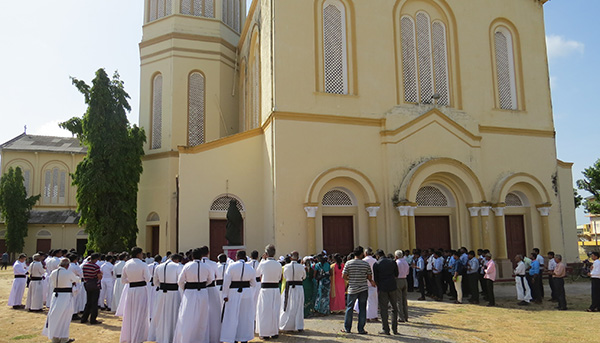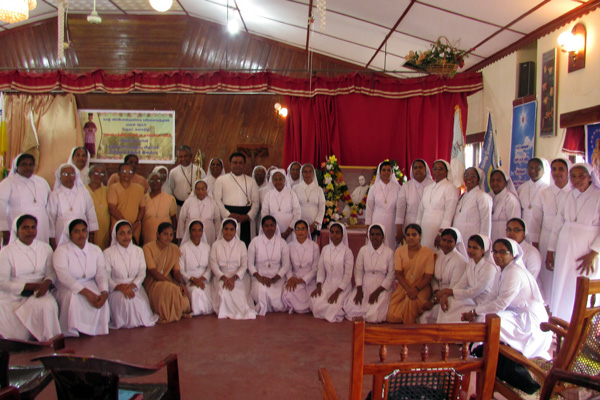Installation of Statue of Bishop Semeria – Jaffna
Sri Lanka
Originally Published on OMIWORLD.ORG
Click here to see the article en Español

The 14th of July was a remarkable day in the historical annals of the Diocese of Jaffna, as it remembered with gratitude the services of the first Oblate Bishop of the Apostolic Vicariate of Jaffna, Bishop John Stephen SEMERIA, as this year marks the 150th year of his heavenly birth.

The day was made significant with two major events, namely the unveiling of a huge, beautiful statue of Bishop Semeria at the Cathedral and a memorial lecture the bishop.
The installation of the statue began with a prayer conducted by the diocesan seminarians. The statue of the bishop was blessed and unveiled by Very Rev. Fr. P. J. Jebaratnam, the Vicar General of the diocese of Jaffna, together with the Oblate provincials of the Provinces of Jaffna and Colombo, Frs. Edwin VASANTHARAJAH and Irwin MORAES, and the provincial of the Holy Family Sisters of Bordeaux. There was a good number of people: Oblate Lay Associates, seminarians, Holy Family Sisters of Bordeaux, priests of the diocese of Jaffna and other religious.

The memorial lecture on Bishop Semeria took place at the nearby hall immediately after the installation of the statue. It began with prayer and a cultural welcome dance performed by members of MAMI. It was followed by the lighting of the traditional lamp and the garlanding of the picture of Bishop Semeria by Father Moraes. The Oblate Provincials and the Provincial of the Holy Family Sisters of Bordeaux addressed the gathering on the contribution of Bishop Semeria to the Church of Sri Lanka.

The climax was the memorial lecture on the “Challenges Bishop Semeria encountered.” The lecture was delivered by Prof. Rev. Dr. S.V.B Mangalarajah, Jaffna diocesan priest, senior lecturer at the Jaffna diocesan major seminary, who is a well-known historian in the country. He spoke of the challenges that the bishop faced with his predecessor, Bishop Orazio Betachini, the first Apostolic Vicar of the Vicariate and with the Oratorian Missionaries who came from Goa, India, and looked after these lands for a long period of time before the Oblates. He spoke of Bishop Semeria’s capabilities as an administrator and how he met the challenges and situations of his day. The day’s-programme came to end with the Oblate anthem. (Fr. A. X. AMALRAJ)
The day was made significant with two major events, namely the unveiling of a huge, beautiful statue of Bishop Semeria at the Cathedral and a memorial lecture the bishop.
The installation of the statue began with a prayer conducted by the diocesan seminarians. The statue of the bishop was blessed and unveiled by Very Rev. Fr. P. J. Jebaratnam, the Vicar General of the diocese of Jaffna, together with the Oblate provincials of the Provinces of Jaffna and Colombo, Frs. Edwin VASANTHARAJAH and Irwin MORAES, and the provincial of the Holy Family Sisters of Bordeaux. There was a good number of people: Oblate Lay Associates, seminarians, Holy Family Sisters of Bordeaux, priests of the diocese of Jaffna and other religious.

The memorial lecture on Bishop Semeria took place at the nearby hall immediately after the installation of the statue. It began with prayer and a cultural welcome dance performed by members of MAMI. It was followed by the lighting of the traditional lamp and the garlanding of the picture of Bishop Semeria by Father Moraes. The Oblate Provincials and the Provincial of the Holy Family Sisters of Bordeaux addressed the gathering on the contribution of Bishop Semeria to the Church of Sri Lanka.
The climax was the memorial lecture on the “Challenges Bishop Semeria encountered.” The lecture was delivered by Prof. Rev. Dr. S.V.B Mangalarajah, Jaffna diocesan priest, senior lecturer at the Jaffna diocesan major seminary, who is a well-known historian in the country. He spoke of the challenges that the bishop faced with his predecessor, Bishop Orazio Betachini, the first Apostolic Vicar of the Vicariate and with the Oratorian Missionaries who came from Goa, India, and looked after these lands for a long period of time before the Oblates. He spoke of Bishop Semeria’s capabilities as an administrator and how he met the challenges and situations of his day. The day’s-programme came to end with the Oblate anthem. (Fr. A. X. AMALRAJ)
